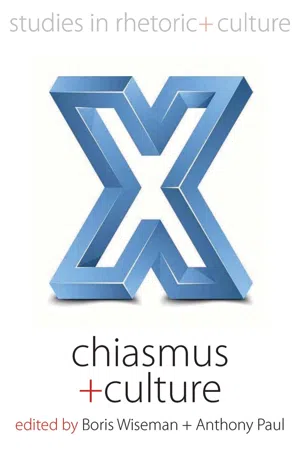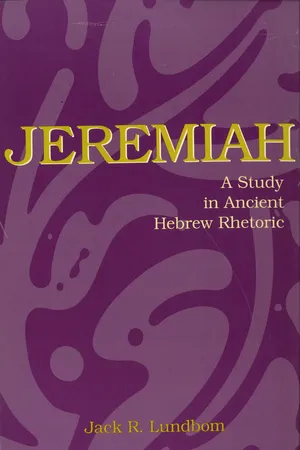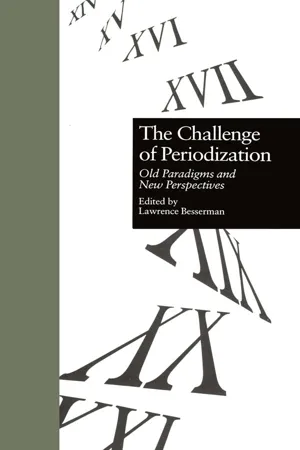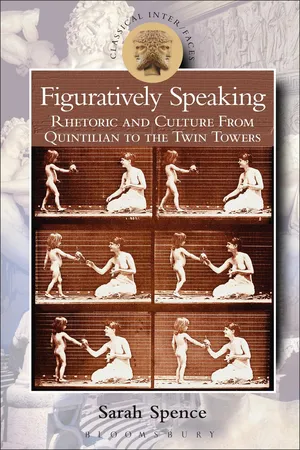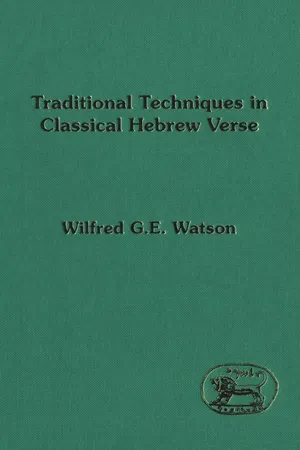Literature
Chiasmus
Chiasmus is a rhetorical device in which the order of words in one phrase is reversed in the following phrase, creating a balanced and parallel structure. It is often used to emphasize contrast or to create a memorable and impactful statement. An example of chiasmus is the famous quote by John F. Kennedy, "Ask not what your country can do for you, ask what you can do for your country."
Written by Perlego with AI-assistance
Related key terms
1 of 5
7 Key excerpts on "Chiasmus"
- eBook - PDF
- Boris Wiseman, Anthony Paul(Authors)
- 2014(Publication Date)
- Berghahn Books(Publisher)
46 ■ Robert Hariman So it is that Chiasmus is both a trope and a figure, a small device and a generative form, and its combination of rhetorical power and evident artificiality leads to restricted use. Chiasmus is found in Biblical narrative, Renaissance drama, modern poetry, urbane conversation, and great oratory, but rarely on the street. People admire it, scholars study it, writers practise it and play with it, but you can be immersed in newspapers, television, email, and the many other venues of ordinary speech for months and never see it or notice it. Nor is this because the figure is hard to use. Unlike jokes, for example, which are far harder to write (and deliver) than to enjoy, anyone could bundle words into the ABBA form if given a few examples and some small incentive: we should make our words fit our ideas, and our ideas fit our words; I don’t like snow in the winter, but I don’t like winter without snow; put a song in your heart, and your heart into a song. Do this occasionally, and you can acquire a reputation for having a way with words; keep it up and you will drive people nuts. The point of these observations is not to locate the proper place for this or any other verbal technique in a pantheon of tropes, figures, schemes, or other discursive forms. Instead, the Chiasmus invites consideration of the nature of rhetoric itself, and there of how compositional devices can be both small and large, full and empty, static and generative, encompassing and self-limiting, social and narcissistic, alien and all too human. The rest of this essay develops an answer to the question, ‘What is a chi-asmus?’ The answer will not be a definition but rather a discourse on why the Chiasmus is particularly well suited for representing the gap between language and reality, and thus for representing language itself – and language divided against itself, as de Man argued. - eBook - ePub
- Ivo Strecker, Stephen Tyler, Ivo Strecker, Stephen Tyler(Authors)
- 2009(Publication Date)
- Berghahn Books(Publisher)
However, scholars today accept the existence of more complex forms of chiasm that can extend over many pages of prose or verse. Such forms of chiastic reversals cannot be defined in terms of a simple grammatical inversion of the kind exemplified above. In ancient texts, these more complex chiasms are supposed to have had a mnemonic function or to have played a role similar to that of punctuation in texts in which punctuation was not yet used—for example, to signal a conclusion (Welch 1981: 12). The bible, in particular, makes much use of an extended version of the ABBA structure, in the form of lists that conform to sequences of the following kind: A-B-C-D-E-E′-D′-C′-B′-A′ (Welch 1981: 7). The key features of Chiasmus—whatever the level of organization of a discourse where it occurs—are inversion, balance, and a certain foregrounding of the center point around which the system inverts. Chiasmus consists in “the appearance of a two-part structure or system in which the second half is a mirror image of the first, i.e. where the first term recurs last, and the last first” (Welch 1981: 10). On this basis, I propose to use the term Chiasmus here to denote, in Lévi-Strauss’s works, a form of inverted parallelism or inverted symmetry, an antithetical relationship between two terms so that each offers an inverted mirror image of the other. It is this figure of thought that I am suggesting is characteristic of a certain kind of Lévi-Straussian argument—its thematic structure, its way of unfolding—one whose deeper significance I will try to interpret here; my premise being that it has a significance or function and that it is not merely decorative or rhetorical, in a pejorative sense. A good example of a chiastic inversion of this kind is to be found in one of Lévi-Strauss’s best known texts, the “Ouverture” to the Mythologiques, his tetralogy on Amerindian mythology - eBook - PDF
Jeremiah
A Study in Ancient Hebrew Rhetoric
- Jack R. Lundbom(Author)
- 1997(Publication Date)
- Eisenbrauns(Publisher)
2. Chiasmus in the New Testament, 59. 3. Ibid., 44. Chiasmus 83 In our present study we will require that speeches have at least some key words before a Chiasmus of thought is proposed. In the larger editorial structures too, key words can almost al- ways be found which make the Chiasmus more certain. We would like to know more about ancient Hebrew thought pat- terns, but this much we do know, that verbal association was widely used in all levels of discourse, and we are therefore well advised to stay close to the speci˜c vocabulary of the text in at- tempting to ˜nd our rhetorical structures. Another kind of Chiasmus not recognized by Lund has been observed by Loh˜nk, and signi˜cantly for us it appears in Deu- teronomy. This is a Chiasmus of speaker. In Deut 1:20–31, Moses narrates in the ˜rst person, introducing the direct address of each of the participants in a discussion—including himself—in chi- astic fashion: 4 A Moses speaks (20–21) B People speak (22) C Explorers speak (25) Bu People speak (27–28) Au Moses speaks (29–31) Loh˜nk of course does not consider this order fortuitous. Struc- tures in Deuteronomy are intended by their authors to be audi- tory signals for a people who must listen to material being read to them aloud. 5 We will see this same type of Chiasmus in Jere- miah where it becomes almost as important as the key-word type in structuring the Jeremianic speech. Chiasmus within the Jeremianic Poems In Hebrew poetry Chiasmus is a syntactic structure at base which inverts normal word order. It works especially well in a poetry which makes use of parallelism. Holladay says it serves to “vary the steady drumbeat of the normal [i.e., parallel] pat- tern.” 6 Syntactic Chiasmus is commonly found in all Old Testa- ment poetry so we need not make too much of its existence in Jeremiah. But since we are going to show how Jeremiah expands 4. Lectures in Deuteronomy , 15. 5. Ibid., 5. 6. “The Recovery of Poetic Passages of Jeremiah,” 409. - eBook - PDF
The War Between the Two Beasts and the Two Witnesses
A Chiastic Reading of Revelation 11:1-14:5
- Tony Siew(Author)
- 2005(Publication Date)
- T&T Clark(Publisher)
Ancient writers often employed key terms as catchwords to link passages together, although the material they considered central does not always match modern preconceptions of what is important. 5. Both the verbal and conceptual parallelisms should use words and ideas not regularly found elsewhere within the proposed Chiasmus. Most unpersuasive proposals fail to meet this criterion; while the pairings suggested may be plausible, a little ingenuity can demonstrate equally close parallelism between numerous other pairs of passages which do not support a chiastic whole. 6. Multiple sets of correspondences between passages opposite each other in the Chiasmus as well as multiple members of the Chiasmus itself are desirable. A simple ABA' or ABB'A' pattern is so common to so many different forms of rhetoric that it usually yields few startlingly profound insights. Three or four members repeated in 204. C. Blomberg, 'The Structure of 2 Corinthians 1-7', CTR 4 (1989), pp. 3-20 (5-7). 52 The War Between the Two Beasts and the Two Witnesses inverse sequence may be more significant. Five or more elements paired in sequence usually resist explanations which invoke subconscious or accidental processes. 7. The outline should divide the text at natural breaks which would be agreed upon even by those proposing very different structures to account for the whole. If a proposed Chiasmus frequently violates the natural 'paragraphing' of the text which would otherwise emerge, then the proposal becomes less probable. 8. The center of the chiasm, which forms its climax, should be a passage worthy of that position in light of its theological or ethical significance. If its theme were in some way repeated in the first and last passages of the text, as is typical in Chiasmus, the proposal would become that much more plausible. 9. Finally, ruptures in the outline should be avoided if at all possible. - eBook - ePub
The Challenge of Periodization
Old Paradigms and New Perspectives
- Lawrence Besserman(Author)
- 2014(Publication Date)
- Routledge(Publisher)
To be sure, each of these verses is made up of antithetical elements. The second verse, which is more obviously antithetical, makes explicit and confirms the antithesis between “Heav’n” and “tortures” deployed in the first. Yet as a whole the couplet engenders a figuration of Chiasmus which is not primarily an activity of exclusion or appropriation, such as antithesis alone would produce. A large part of my argument in this essay has to do with the fact that Wordsworth is wondrously forgetful of this wholly different working of Chiasmus—forgetful of it in this couplet of Pope, as well as in neoclassical poetry in general. I will indicate, however, that in other ways he is also wondrously mindful of it: namely, when he sets his own chiastic structures into motion. Wordsworth’s doubleness on this score, I claim, is a function of the co-subjective potential of Chiasmus. This co-subjective potential comes about because Chiasmus itself entails recreating an emptiness or obliviousness within language. This emptiness results in the Teachings out of language, from its incompleteness or obliviousness, towards symmetry with other language. It will emerge that in Wordsworth’s own writing he is partly forgetful, partly mindful, of the way the neoclassical counterparts to his own use of Chiasmus half-form his poetic tradition.In order to appreciate the frequency of such half-forgettings, together with their half-rememberings, it is necessary to see that occurrences of Chiasmus are far more common than we may imagine. Handbooks of rhetorical terms only say that Chiasmus consists of a reversal of syntactic elements, or signs, which form an X or chi within the pattern AB:BA. For one phase of Chiasmus this is certainly true, and it is therefore legitimate to think of Chiasmus in terms of antithesis or opposition. Yet formally as well as historically considered, it is more accurate to say that a Chiasmus is a movement of two sets of opposed signs (two binarisms) in which the pattern AB:BA is only one interim possibility. Because of the multiple meanings of all language, any one reading (at a given juncture of possible combinations) of any sign or syntactic element or binarism is always to some extent an arbitrary decision. In Pope’s couplet, for example, this is the case with each of the four binary terms located by his four half-lines. Each binary term is poised for a change of its sign (A or B) within the couplet’s network of signs. Henri Suhamy has recently emphasized this feature of shifting signs within the structure and movements of any Chiasmus. He notes that in its mirror arrangement the binary terms, passing from one syntactic element to the next, as much reflect as oppose each other.5 - eBook - PDF
Figuratively Speaking
Rhetoric and Culture from Quintilian to the Twin Towers
- Sarah Spence(Author)
- 2013(Publication Date)
- Bristol Classical Press(Publisher)
The tension is represented most clearly by the figure of chiasm. The name derives from the Greek letter C , chi, since the figure works by inverting terms. That chiasm surfaces as the key figure, at least in the literature after that time, has been shown by John Hollander, 97 who points out in Melodious Guile that the specular figure of Chiasmus (a:b::b:a) ‘has [by the Renaissance] come to be a scheme of schemes’: there is … something deeply compelling about this myth of chiasm as mirror. … The mirror is human thinker, transient and mortal like that which he or she reflects and reflects upon. 2 Hollander isolates the possible locus classicus in John Milton (1608-74) where the description of Eve seeing her own image is expressed in chiastic terms ( Paradise Lost 4.460-2): As I bent down to look, just opposite A shape within the watery gleam appeared Bending to look on me … Yet the examples abound. Take, for example, this letter from Milton’s contemporary, the Puritan author Anne Bradstreet (1612-72), to her son, written in 1664: Parents perpetuate their lives in their posterity and their manners; in their imitation children do naturally rather follow the failings than the virtues of their predecessors, but I am persuaded better things of you. You once desired me to leave something for you in writing that you might look upon, when you should see me no more; I could think of nothing more fit for you nor of more ease to myself than these short meditations following. Such as they are I bequeath to you. 3 The ‘I bend-down-look: bend-down-look me’ Hollander identifies in the Milton is echoed by the ‘You desired me: I desired [think of nothing more fit for] you’ of the Bradstreet. Both Milton and Bradstreet link Chiasmus with specularity – in the structure of sentences, in the essential meaning – that functions on surface and sublexical levels. 98 Figuratively Speaking Chiasm, Hollander makes clear, was initially only a figure of speech. - Wilfred G. E. Watson(Author)
- 1994(Publication Date)
- Sheffield Academic Press(Publisher)
2.5.1. Chiasmus and Other Structural Devices The devices to be considered are anacrusis, ballast variant, the terrace pattern (anadiplosis), word-pairs, the list, the pivot pattern and key-words. Incremental repetition and the acrostic will be treated only briefly. The accompanying chart (Table 6) will help both for com-parative purposes and as a convenient summary. a b a chiastic monocolon x anacrusis (2.5.1) a b c c b a a b c ballast variant (2.5.2) c 1 b' d' a b terrace pattern (2.5.3) b a c d a b p pivot pattern b' a' (bicolon with silent stress) (2.5.6) a b incremental repetition a c Table 6. Chiasmus and Related Patterns Chiasmus and Anacrusis. Anacrusis is the presence of an extra-metrical word (or words), generally at the beginning of a line. 201 Similarly, a word (or words) can stand outside the chiastic pattern: Prov. 6.23 For, a lamp is a command, teaching is a light 200. I still prefer 'poetic devices' to 'rhetorical devices' because the term 'rhetorical' has negative overtones and because 'poetic' is a better description. 201. T.H. Robinson, 'Anacrusis in Hebrew Poetry', in P. Volz and F. Stummer (eds.), Werden und Wesen des Alten Testaments (BZAW, 66; Berlin: de Gruyter, 1936), pp. 37-40. 7. Chiasmus 375 the pattern being x-ab // ba, x representing the extra-chiastic word ki. Also, with both Chiasmus and anacrusis: Isa. 17.10; Amos 5.4-6; Pss. 67.5; 107.9, 11; Isa. 5.20, 21 (hoy, 'woe'); Hos. 4.4 ('ak, 'surely'); Ps. 9.19 (ki Id', 'for not'). Chiasmus and Ballast Variant. In a parallel couplet or bicolon, an equivalent to a word in the first line is sometimes missing from the second. In compensation, the balance is maintained by a lengthening of one of the elements in the second colon. The longer element, called 'ballast variant' is also termed 'expletive' or 'filler' and is characteris-tic of oral poetry.
Index pages curate the most relevant extracts from our library of academic textbooks. They’ve been created using an in-house natural language model (NLM), each adding context and meaning to key research topics.
